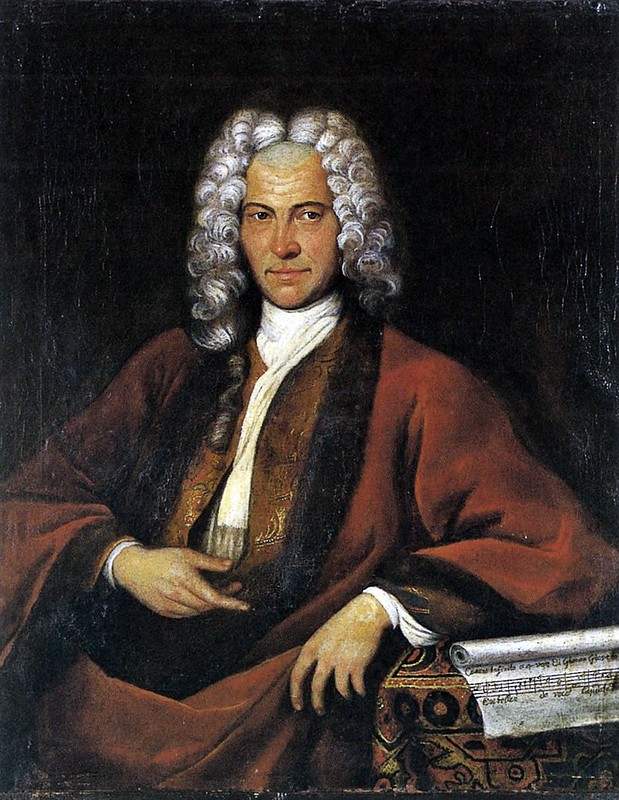Johann Joseph Fux (1660-1741)
- Missa (G-Dur) pro Gratiarum Actione
Performers: Cаppellа Novа Grаz; Ottο Kаrgl (leitung)
Further info: Johann Joseph Fux (1660-1741) - Kaiserrequiem (1720)
---
Austrian composer and music theorist. Fux's exact date of birth is
unknown. According to his death certificate he was 81 when he died. His
father, Andreas (c.1618-1708), married twice, and Johann Joseph may have
been his eldest child. Although a peasant, Andreas Fux was a parish
official attached to the church at St Marein and came into contact with a
number of musicians, among them the Graz organist J.H. Peintinger and
the Kantor Joseph Keller, who probably influenced his son's early
musical development. In 1680 Fux enrolled as a ‘grammatista’ at Graz
University, and in 1681 he entered the Jesuit Ferdinandeum as a student
of grammar and music. By August 1685 he had taken a position as organist
at St Moritz in Ingolstadt. Fux's movements between the beginning of
1689, when a new organist was appointed at St Moritz, and his marriage
in 1696 remain uncertain. Although Fux's employment as court composer in
Vienna dates officially from April 1698, he himself was ambiguous about
his length of service in this capacity. In various documents, he
implied that he began to work for the imperial household in 1695, or
even 1693. Together with the recently appointed composers Badia,
Giovanni Bononcini and Marc’Antonio Ziani, Fux effectively began to
introduce elements of late Baroque style into the sacred and secular
genres cultivated at court. After the death of Leopold I in 1705 and the
accession of his son Joseph I, Fux retained the office of court
composer. In the same year he was appointed deputy Kapellmeister at the
Stephansdom, where in 1712 he succeeded J.M. Zacher as first
Kapellmeister. He retained this office until the end of 1714, and during
the same period he also directed services at the Salvatorkirche. His
duties as deputy Kapellmeister at the Stephansdom centred on the music
performed before the statue of Our Lady of Pötsch, which the emperor had
had placed on the high altar of the cathedral in 1697. After the
unexpected death of Joseph I on 17 April 1711, the empress-regent
Eleonora dissolved the Hofmusikkapelle, and many of its personnel,
including Bononcini and Badia, were pensioned.
By October 1711 Fux had been appointed deputy Kapellmeister to the
court. In January 1715 Charles VI appointed Fux as Hofkapellmeister, a
position he held for the rest of his life. As a composer who served
three emperors, Fux undertook an especially taxing combination of
duties. His coronation opera, Costanza e Fortezza, nominally in
celebration of the Empress Elisabeth Christine's birthday but
effectively written to mark the coronation of Charles VI as King of
Bohemia, represents the peak of his public office. The publication of
the Gradus ad Parnassum in 1725 has been compared in importance with the
publication of Fischer von Erlach's Entwurf einer Historischen
Architektur (Vienna, 1721). Both works embody the concept of Habsburg
style selfconsciously, and persuasively relate their author's
achievements to a coherent past. On 8 June 1731 Fux's wife died, and
some seven months later the composer drew up his will (5 January 1732).
His activities at court notably decreased, with many of his
responsibilities being assigned to Caldara and others. He had complained
of serious illness at the close of the Gradus, and by the late 1720s
his rate of composition had sharply declined. His last testimonial is
dated 10 March 1740. On 13 February 1741 he developed a ‘raging fever’
and died. He was much mourned at court. The most outstanding of his many
students were Gottlieb Muffat, G.C. Wagenseil and J.D. Zelenka.
According to C.P.E. Bach, J.S. Bach placed him first among those
contemporary composers whom he most admired. Fux represents the
culmination of the Austro-Italian Baroque in music. His compositions
reflect the imperial and Catholic preoccupations of the Habsburg
monarchy no less than does the architecture of Fischer von Erlach or the
scenic designs of the Galli-Bibiena family. His Gradus ad Parnassum
(1725) has been the most influential composition treatise in European
music from the 18th century onwards.

Cap comentari:
Publica un comentari a l'entrada